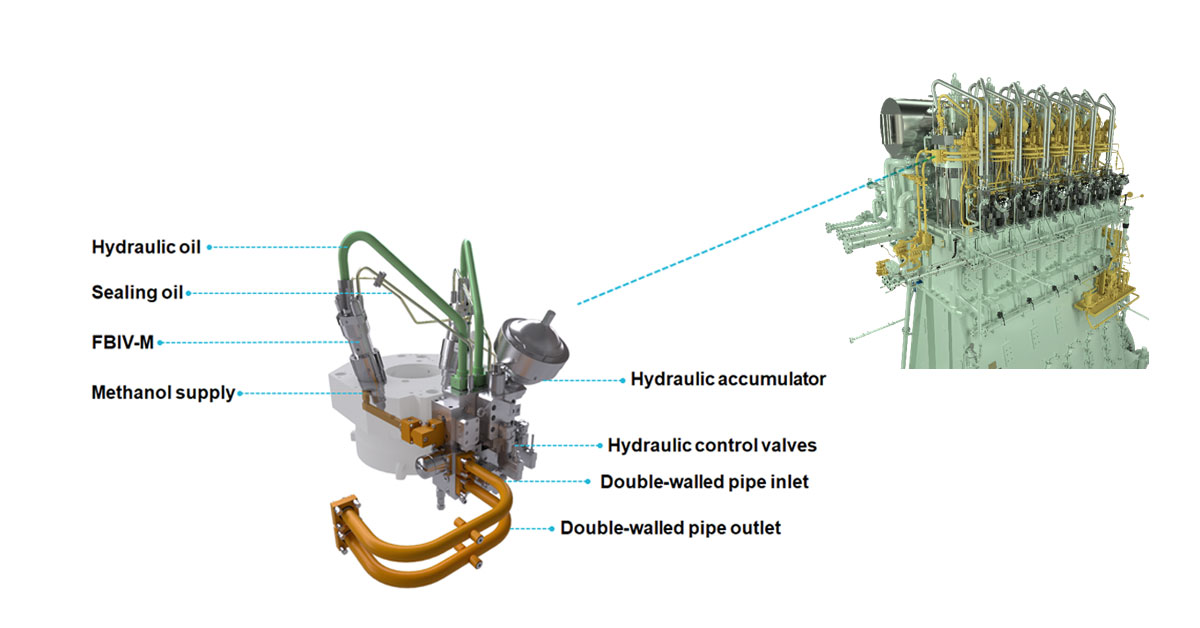Enabling a scalable energy transition
The MAN B&W ME-LGIM two-stroke dual-fuel engine can run on methanol as well as conventional fuels. Specifically designed to meet the needs of the maritime industry, it is a versatile and scalable solution that is suited to a wide range of vessel types. Simple handling, storage, and bunkering of methanol, combined with relatively simple auxiliary systems and the potential to be carbon-neutral, makes it an attractive option for meeting decarbonization targets.
Proven two-stroke methanol engine design
Available either for newbuilds or for upgrading existing conventional fuel vessels, this engine represents a proven, refined engine design based on over 600,000 running hours on methanol alone. Methanol produced from renewable sources is an attractive marine fuel option due to its low carbon intensity. An engine using green methanol can even provide carbon-neutral propulsion.
Key benefits
A new design for efficient methanol combustion
The ME-LGIM engine has inherited well-known components of our standard two-stroke diesel engine, like the ME-GI dual-fuel engine. Beneficial features of the standard MAN B&W two-stroke diesel engine have been retained. This illustration highlights methanol components and pipes that have been added to the cylinder top for methanol combustion.
The use of methanol as fuel type supports cost-effective vessel designs.

Moving together into a sustainable future
Learn more about the MAN B&W ME-LGIM engine
Continue reading
-
MAN B&W ME-LGIMpdf, 504 KB
Related products
Related News
Tier III NOx-Abatement Engine Orders Pass 2,000 Mark
MAN Energy Solutions’ Two-Stroke Business has announced that it has surpassed 2,000 orders for IMO MARPOL Annex VI NOX Tier III-compliant technologies for its portfolio of MAN B&W two-stroke engines. The new milestone occurs just over a year after the company announced the passing of the 1,000 milestone in January 2021.
Bjarne Foldager – Senior Vice President and Head of Two-Stroke Business – MAN Energy Solutions, said: “This welcome milestone is built on the experience we have gathered over the past decade. Our fully-mature EGR and SCR systems deliver Tier III NOx-compliance and improve engine performance in terms of increased fuel efficiency and lower, general emissions. Our ability to treat a ship as a complete system gives us a clear market advantage that enables us to prioritise environmental considerations and system integration.”
Among other statistics, MAN Energy Solutions reports:
- Determined by bore size, 50- and 60-bore MAN B&W engines account for most NOx solutions (37%);
- EGR accounts for 724 vs 1,292 SCR solutions.
Furthermore, the company reports that some 67 engines were equipped with EcoEGR, representing about 9% of all EGR solutions. EcoEGR is a tuning method that lowers fuel consumption by recirculating a small amount of exhaust gas while operating in Tier II.
Foldager added: “Considering how NOx Tier III limits were only introduced in 2016, shipping has come a long way in a short period of time. MAN Energy Solutions is rightly proud to have brought three technologies – in the form of EGR, and low- and high-pressure SCR variants – to market such that every owner and ship designer can select what best fits their individual project.”
In relation to EGR, Stig B. Jakobsen – Senior Manager, Two-Stroke Operation – MAN Energy Solutions, said: “More than ten years of service experience with our EGR design has enabled us to introduce refinements and optimisations. The latest design is a perfect example of such optimisation since we employ our fourth-generation EGR in our low-pressure, dual-fuel ME-GA engine. EGR has become an integral tuning tool for each of our low-speed engines and its maturity will allow us to further explore the potential for optimising engine performance well into the future.”
NOx solutions
Exhaust Gas Recirculation (EGR) prevents the formation of NOx by controlling the combustion process, while Selective Catalytic Reduction (SCR) uses a catalyst and an additive to remove the NOx generated by the combustion process as an after-treatment process.
Uniquely for the two-stroke sector, MAN Energy Solutions offers both EGR and SCR as proprietary NOx solutions. The company has long experience with EGR technology and reported its first order already in 2011, while its own in-house-developed SCR-HP (-High Pressure) won its first order in January 2019. This features a drastically reduced reactor-size, compared to rival systems, to which MAN Energy Solutions has been providing system approval since 2014.
Methanol-fuelled, MAN B&W LGIM engines have a special feature as explained by Kjeld Aabo – Director of New Technologies – MAN Energy Solutions: “Through the use of water emulsion in the methanol, we are able to reach Tier III levels in methanol fuel-mode, completely removing the need for a dedicated NOx-abatement technology. Our introduction of this on our G50-LGIM engine gains us highly valuable service experience – especially in the methanol-carrier segment – while we see a very clear demand for full Tier III-compliance across all fuel types outside this segment by means of EGR.
Documents
-
PR 2000 Tier III Engines_EN
Contact
Nils Søholt
Trade Press Marine
Group Communications & MarktingMAN Energy SolutionsTeglholmsgade 412450 Copenhagen SVDenmark
nils.soeholt@man-es.com t +45 33 85 26 69Available languages
- DE ·
- EN
Get notified about press releases
Alternative fuels for your two-stroke powered vessel: Ammonia, methanol and methane in focus
Register for our next MAN ExpertTalk on alternative fuels for large merchant marine vessels. We will provide insights into the most promising marine fuels of the expected future fuel mix for two-stroke vessels, namely ammonia, methanol and methane.
Further, we will inform about the latest product developments and applications as well as reasons why these fuels have the potential to offer a straightforward path for the future maritime energy transition.
- Wednesday, April 24, 15:00 – 15:45 (W. Europe Standard Time)
- Thursday, April 25, 10:00 – 10:45 (W. Europe Standard Time)
